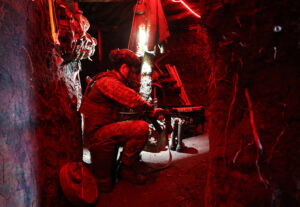Over the past year and a half, calls for peace negotiations between Ukraine and Russia have been widely dismissed by the Ukrainian government and its more maximalist online supporters as either Putinist propaganda or defeatism. Yet the so-far lacklustre results of Ukraine’s long-awaited counteroffensive have rendered the entire debate moot: right now, there is no incentive whatsoever for Russia to enter into negotiations.
As Russia’s Foreign Minister Sergey Lavrov declared last week: “The prospects for negotiations between Russia and the West are non-existent at this stage.” Indeed, Lavrov applies precisely the same argument against peace talks that both Ukraine and its Western advocates made at an earlier stage in the war: that “we regard the Westerners’ hypocritical calls for talks as a tactical ploy to buy time once again, giving the exhausted Ukrainian troops a respite and the opportunity to regroup and to send in more weapons and ammunition”. It takes two sides to negotiate, and even if Washington compelled Kyiv to the table, Moscow will not currently accept concessions distinguishable from surrender, impossible for Ukraine to accept and damaging for America to oversee.
From Moscow’s perspective, the war is settling into a comfortable rhythm: the modern armour that Ukraine had demanded for so long, whose delivery elicited such angst and drama in Western capitals, is being expended against Russia’s defensive lines to little effect, at least so far. The spring’s flurry of gruesome drone videos showing Russian deaths up close has been inverted, with Russia’s supporters now exulting in the extinction of Ukraine’s increasingly precious reserves of manpower at the hands of cheap FPV drones. The Russian economy is faring better under Western sanctions than anyone expected, while European governments ride the discontent of their voters over rising living costs. On the diplomatic front, non-Western powers view the war in Ukraine with either unruffled equanimity or quiet satisfaction, happy to trade with Russia at discount prices and to assume a role in the multipolar order now demonstrably coming into being. Far from being isolated, Russia’s role in Africa is rapidly expanding as that of the West deteriorates. The greatest threat to Ukraine’s survival, the fickle will of America’s turbulent democratic system, is slowly proceeding in the direction Putin always hoped. The war may not be the stunning success Putin initially hoped for, but its recent trends seem broadly favourable for Moscow, and its disadvantages currently manageable. The necessity for Ukraine now is to once again overturn this calculus.
In these circumstances, there is something distasteful about the flurry of anonymous briefings with which the Biden administration is now distancing itself from Ukraine’s ill-starred counteroffensive. Its results have not, after all, come as a surprise to American planners: as the Discord intelligence leaks revealed, back in February, the Pentagon was already warning that the offensive was likely to fall “well short” of its stated goals: Russia’s sophisticated trench fortifications, coupled with Ukraine’s “force generation and sustainment shortfalls” and “enduring Ukrainian deficiencies in training and munitions supplies”, would “exacerbate casualties during the offensive”, while achieving only “modest territorial gains”. While there are serious dissenting opinions, which assert that the attrition of both Russia’s artillery and manpower under Ukrainian assault will eventually bear fruit, the results so far seem to bear out the accuracy of America’s initial assessment.
Given the vast disparity between Russia and Ukraine in size, population, wealth and industrial production, a strategy of attrition in which Ukraine bears the costs of assault appears a risky gamble. It was always improbable that Ukraine’s army could entirely reshape its military doctrine along Nato lines in a matter of months to defeat, without any of the air superiority integral to the American way of war, a dug-in enemy many times its size. It was Ukraine’s more excitable online supporters, and not the American defence establishment, which had made the grandest claims for the coming offensive, while talking down Russia’s military potential, and it would seem unfair for Kyiv to now pay the price of their reckless if well-meaning exuberance.
The Biden administration’s approach to the war has always been fundamentally sound: that Ukraine should be supported to negotiate, but only from a position of relative strength. Yet it is no good to belatedly observe, as US officials are now anonymously wont to do, that perhaps America’s top general Mark Milley was right in claiming that Ukraine’s greatest period of relative strength was last winter, following the unexpected success of the Kherson and Kharkiv offensives, when an overstretched Russia was on the ropes and seemingly willing to negotiate. True, back then, Ukraine’s star was ascendent and the planned offensive, then slated for the spring, seemed fraught with terrible potential for Russia’s leadership. Yet even then, Russia insisted on Kyiv recognising Moscow’s possession of the Ukrainian territories it had just abandoned, an impossible starting condition for talks.
Even the best chance of peace, the direct talks overseen by Turkey following Russia’s abandonment of its initial regime-change blitzkrieg, were stymied by the atrocities in Bucha and Irpin which Russia’s sudden withdrawal from northern Ukraine revealed. Seemingly a product of ill-discipline rather than top-down policy, the torture and murder of Ukrainian civilians which made negotiations impossible for Kyiv may eventually be recorded as some of the costliest individual crimes in Europe’s history: half a million casualties on both sides have followed, according to US officials. There have, therefore, been precisely two opportunities for meaningful negotiations in the war’s first year and a half, and both were made politically impossible by either Moscow’s unreasonable demands or by the actions of the troops under its command.
It had been hoped that the improved negotiating position necessary for meaningful talks would blossom from Ukraine’s counteroffensive, yet without dismissing the possibility of a sudden breakthrough, it would surely now be sensible to consider the alternatives. Writing for UnHerd, the eminent American strategist Edward Luttwak proposes Ukraine rolls the dice towards total mobilisation, conscripting a three-million-man army to fend off the Russian threat. This would be a bold, perhaps desperate gamble, which would either break the back of the Russian army or destroy Ukraine. The quality of Ukraine’s armed forces has seemingly deteriorated as the eager volunteers of the war’s early months have been replaced by often unwilling conscripts, and the newly raised and Western-trained brigades designed to spearhead the offensive have not performed as well as hoped. Further waves of Ukrainian mobilisation will surely be necessary, but it would be rash at this delicate stage to gamble the country’s survival on any imminent offensive feats from its new levies.
Perhaps a more cautious approach would be for Ukraine to dial down its immediate aims at this waning stage of the summer, hunker down for winter, marshall its resources and assess the possibilities opened up by spring. Instead of pursuing wasteful, symbolic actions such as the attempted reconquest of Bakhmut — a town, we were assured, which held no strategic value — or distracting sideshows like the attempted bridgehead across the Dnieper, if Kyiv does not feel confident in committing its full available might towards the southern offensive, it should disengage and prepare now for what is sure to be a difficult winter. If, as some analysts claim, Kyiv does not possess the command and control capability to undertake anything more than piecemeal company-sized attacks, then it should reassess its strategy, prioritising its actual military capacity over the perceived need to impress the outside world. A strategy of shoring up international support by promising an endless succession of improbable feats is no long-term strategy at all.
Russia’s relative success this summer was the product of its shortening and rationalisation of its lines last autumn, a then-humiliating strategy of the since-jailed General Surovikin which has now borne effective fruit. A Ukrainian disengagement from the current offensive would not necessarily mean ceding territory in the same way Russia did last year: the past two and a half painful months of Ukraine’s offensive have all taken place in the contested “grey zone” no-man’s-land in front of Russia’s first fixed line of defence, and there is nothing to prevent Ukraine using its remaining manpower, artillery and mobile armoured reserves in a similar way. Nor does it preclude striking targets of opportunity should the occasion arise, shorn of the unrealistic expectations and long-telegraphed objectives of the delayed counteroffensive.
Instead of expending political capital on procuring costly, high-tech weaponry such as the F-16 jets which will not be in meaningful service until the end of the decade, Kyiv may better choose to focus on low-cost, easily-produced weapons such as the suicide drones with which Russia is wreaking such havoc on Ukraine’s own forces. Pin-prick crossborder stunts like UAV attacks and short-lived incursions on Russian territory may play well on social media but unsettle Ukraine’s increasingly unreliable American sponsor, and are brushed aside as annoyances by Moscow. Instead, Kyiv should focus on shifting the human and materiel costs of the war back onto Russia, by forcing Putin to return to the offensive.
While the conditions which allowed Ukraine to undertake a daring and effective offensive last autumn no longer exist, Ukraine has already demonstrated its capacity for tenacious defence against overwhelming odds, and nothing has changed in this regard. Though Russia has succeeded in taking two cities, Mariupol and Bakhmut, against a determined Ukrainian defence, it did so both times at immense cost, and by effectively freezing offensive operations elsewhere in the country. Russia’s developing mini-offensive against Kupiansk will be a test of its current offensive capacity, and there is no reason to believe that Moscow will find the going any easier. On the contrary, Prigozhin’s impromptu coup adventure has made Wagner’s deployment a less glittering weapon in Putin’s armoury, and while recent mobilisation efforts may have shored up Russia’s defensive lines, it is doubtful Moscow can sustain major offensive action without further, politically costly waves of conscription. Meanwhile, just as it was last year, Kyiv is protected from invasion from the north by narrow forest roads and impassable marshes; even the sprawling second city of Kharkiv, right on Russia’s border, would be indigestible to the invader.
A temporary emphasis on defence between this autumn and next spring would, therefore, hold little serious threat for Ukraine, but would allow it to shore up its greatest strategic weakness: its place in the American political system. For the brutal truth is that Ukraine’s overriding strategic imperative is not to recapture the Crimea, or the dubiously loyal cities of the Donbas, but to preserve the quasi-alliance with America as long as necessary to ensure the medium-term survival of the Ukrainian state. Without America’s backing, all Europe’s support will fade away with varying degrees of regret and relief; even hawkish Poland’s massive programme of rearmament is not testimony to certainty in a Ukrainian victory.
The uncomfortable reality is that Ukraine’s sovereignty is severely circumscribed by the vagaries of America’s domestic politics. Whether or not Trump evades prison to return to power, and whether or not Biden’s entanglement in a Ukraine corruption scandal entirely unrelated to the war will become politically salient, America’s opposition party is increasingly sour on the Ukraine war, and America’s fickle voters increasingly unwilling to fund Ukraine’s defence further.
Yet instead of shoring up the alliance, the disappointing results of the counteroffensive up to now have exposed rifts between the two countries, a luxury Kyiv cannot afford, far outweighing the importance of the shattered hamlets it has captured. The increasing blame game between anonymous Biden administration officials accusing Ukraine’s army of over-promising and under-delivering on strategy, and Ukrainian officials accusing the West of the same on arms shipments, will not work in Ukraine’s favour over time (indeed, Western diplomats would do well to beware the nascent stirrings of a post-war stab-in-the-back myth now).
Instead of public expressions of eternal support followed by private disavowals, Washington should not now promise Kyiv more than it can realistically expect to deliver, factoring in the possibility of a White House transition. Equally, Ukraine now needs to cut its ambitions to America’s cloth: it should abandon fantasies of carving a humbled Russia into ethnic republics, or bundling Putin into a dock in the Hague, and focus on what can be realistically be achieved over the course of the next year. Both America and Ukraine will need to compromise: Washington by delivering more aid over a longer timeframe than Biden is politically comfortable with, and Kyiv by lowering its goals to match its objective capabilities.
Whether or not a negotiated settlement is desirable, it is not at this time achievable: Ukraine has no choice but to continue fighting, and given its commitment so far, America is morally obliged to continue its support, in a war now unlikely to conclude until the end of next year at the very earliest. Citing the eventual withdrawal from Afghanistan, Lavrov remarked last week that “the United States does not have the best historical record when it comes to supporting its allies”. It would not well-serve Nato, or least of all Ukraine, for Washington to prove him right.
Disclaimer
Some of the posts we share are controversial and we do not necessarily agree with them in the whole extend. Sometimes we agree with the content or part of it but we do not agree with the narration or language. Nevertheless we find them somehow interesting, valuable and/or informative or we share them, because we strongly believe in freedom of speech, free press and journalism. We strongly encourage you to have a critical approach to all the content, do your own research and analysis to build your own opinion.
We would be glad to have your feedback.
Source: UnHerd Read the original article here: https://unherd.com/




